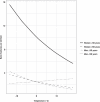The relationship between temperature and hip and wrist fracture incidence
- PMID: 32233845
- PMCID: PMC7374769
- DOI: 10.1308/rcsann.2020.0030
The relationship between temperature and hip and wrist fracture incidence
Abstract
Introduction: Predicting when fracture incidence will rise assists in healthcare planning and delivery of preventative strategies. The aim of this study was to investigate the relationship between temperature and the incidence of hip and wrist fractures.
Methods: Data for adults presenting to our unit with a hip or wrist fracture over a seven and eight-year period respectively were analysed. Incidence rates were calculated and compared with meteorological records. A Poisson regression model was used to quantify the relationship between temperature and fracture rate.
Results: During the respective study periods, 8,380 patients presented with wrist fractures and 5,279 patients were admitted with hip fractures. All women (≥50 years: p<0.001; <50 years: p<0.001) and men aged ≥50 years (p=0.046) demonstrated an increased wrist fracture rate with reduced temperature. Men aged <50 years also had an increased wrist fracture rate with increased temperature (p<0.001).The hip fracture rate was highest in women aged ≥50 years but was not associated with temperature (p=0.22). In men aged ≥50 years, there was a significant relationship between reduced temperature and increased fracture rate (p<0.001).
Conclusions: Fragility fracture of the wrist is associated with temperature. Compared with an average summer, an additional 840 procedures are performed for wrist fractures during an average winter in our trust with an additional 798 bed days taken up at a cost of £3.2 million. The winter increase seen in male hip fracture incidence requires approximately 888 surgical procedures, with 18,026 bed days, and costs £7.1 million. Hip fracture incidence in older women is not related to temperature.
Keywords: Falls prevention; Fracture; Fragility fracture; Osteoporosis.
Figures



References
-
- van Staa TP, Dennison EM, Leufkens HG, Cooper C. Epidemiology of fractures in England and Wales. Bone 2001; : 517–522. - PubMed
-
- British Orthopaedic Association The Care of Patients with Fragility Fracture. London: BOA; 2007.
-
- Department of Health Falls and Fractures. Leeds: DH; 2009.
-
- Gittoes N, McLellan A, Cooper A et al. . Effective Secondary Prevention of Fragility Fractures. Bath: National Osteoporosis Society; 2015.
-
- O’Neill TW, Cooper C, Finn JD et al. . Incidence of distal forearm fracture in British men and women. Osteoporos Int 2001; : 555–558. - PubMed
MeSH terms
LinkOut - more resources
Full Text Sources
Medical

